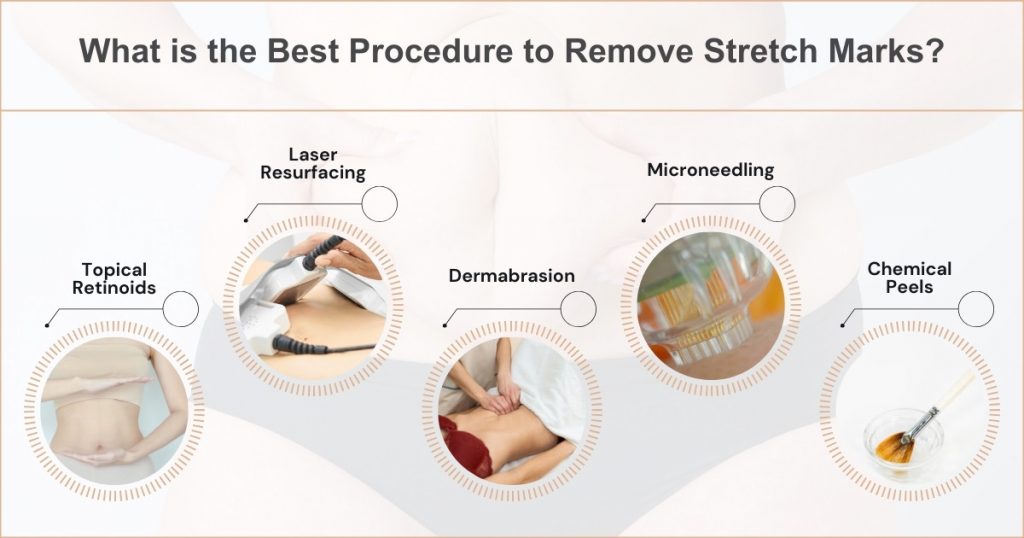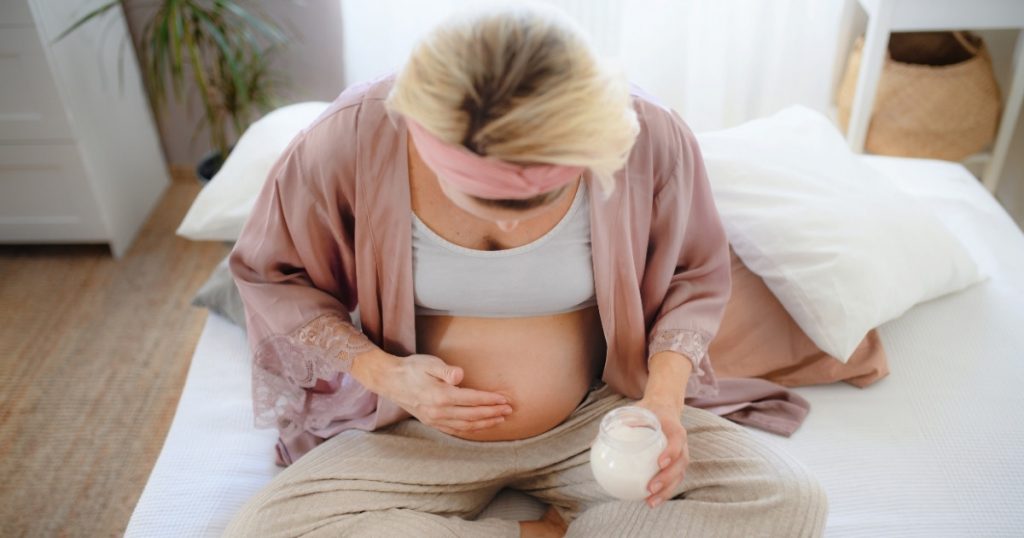A tummy tuck , or abdominoplasty, can dramatically refine body contours by removing loose, overhanging skin and fat and tightening underlying abdominal muscles. However, many plastic surgeons say that while a tummy tuck excels at tightening loose skin on the abdomen, it offers limited improvement regarding stretch marks.
Tummy tuck and stretch marks are related in that though some mild fading of stretch marks is possible after tissue removal and skin tightening, most stretch marks persist to some degree following surgery. Patients considering a tummy tuck should have realistic expectations about the procedure’s abilities and limitations in improving the appearance of stretch marks.
Tummy Tuck and Stretch Marks: What to Expect
A tummy tuck, or abdominoplasty, can help tighten loose abdominal skin and muscles but may not eliminate existing stretch marks in the treated area.
- Oftentimes, stretch marks persist in the upper abdomen after a full tummy tuck.
- Excess loose skin is removed during surgery, not stretch marks or damaged skin.
- It’s unrealistic to expect all stretch marks to vanish completely
- Some fading of stretch marks is possible but varies by individual
- Inform your surgeon ahead of time about existing stretch marks and goals
- There are few surgical options to remove old stretch marks completely
Do Stretch Marks Go Away After a Tummy Tuck?
While stretch marks may fade slightly due to skin tightening and removal of excess tissue, most stretch marks do not disappear entirely after a full tummy tuck procedure .
| Timeline | Visibility | Permanence |
| Immediately after | Hidden by dressings initially | Still present under incisions |
| After dressings removed | Noticeable again | Collagen damage remains |
| First month | Swelling distorts appearance | Are not removed by surgery |
| 3-6 months | Surface wrinkling improves | Most remain visible |
| 1-5 years | Further minor improvement | Never disappear fully |
| With future pregnancy | Likely to return and intensify | Surgery does not prevent recurrence |
This table indicates how the visibility of stretch marks changes over time after a tummy tuck. It demonstrates that while they may fade somewhat, stretch marks do not go away permanently after surgery.
Book A Consultation With Dr Shehzadi Tasneem
Top-rated Plastic Surgeon For Tummy Tuck in Dubai
Installment Plan Available
Stretch marks may recur with future weight fluctuations
How to Minimise Stretch Marks After a Tummy Tuck There are a few techniques that can help reduce the appearance of stretch marks following an abdominoplasty for improved contour and appearance.
- Apply prescription cream with glycolic acid post-surgery
- Use silicone tape or gel sheeting on healing scars
- Follow the surgeon’s instructions for scar care
- Avoid direct sunlight exposure on scars
- Massage scars with moisturiser over time
- Consider laser skin treatments to improve their appearance
- Maintain a healthy, stable weight
What is the Best Procedure to Remove Stretch Marks?

A combination approach yields the best cosmetic results for removing unsightly stretch marks.
| Procedure | How it Works | Pros | Cons |
| Topical Retinoids | Speeds cell turnover to rebuild skin | Improves texture, affordable | Takes several months, irritating |
| Laser Resurfacing | Vaporises skin cells, prompting regeneration | Stimulates collagen, precision | Expensive, significant downtime |
| Dermabrasion | Sands skin using an abrasive tool | Enhances penetration of products | Requires anaesthetic, redness |
| Microneedling | Triggers wound healing with small punctures | Low risk, affordable | Multiple treatments needed |
| Chemical Peels | Applies acid solution to peel skin layers | Tightens skin exfoliates | Causes temporary swelling, stinging |
This table compares common methods for improving the appearance of stretch marks in terms of how they work and their advantages and disadvantages. There is no singular best option for every patient.
Can a Tummy Tuck Get Rid of Old Stretch Marks?
While a tummy tuck is highly effective for tightening loose abdominal skin after weight loss or pregnancy, it cannot erase damaged skin tissue where stretch marks have formed.
- Stretch marks represent injured dermal tissue.
- Old scars have deposited collagen bundles.
- Surgery exercises excess skin only
- Laser or radiofrequency treatments address them better
- Some fading is possible after tissue removal
- Inform surgeon of stretch mark concerns pre-op
- Additional procedures may be required
Does a Tummy Tuck Help With Loose Skin and Stretch Marks?
A tummy tuck procedure, or abdominoplasty, is designed to remove excess loose skin in the abdominal area for a flatter, firmer profile but does not remove existing stretch marks.
- Repairs stretched-out abdominal muscles.
- Tightens remaining abdominal skin after tissue removal
- May achieve slight improvement of stretch marks
- Works well in conjunction with liposuction
- Still require stretch mark treatment afterwards
- Requires about 4-6 week recovery period
- Produces visible scar from hip to hip
What Causes Stretch Marks After a Tummy Tuck?
Several factors can lead to new stretch marks on the abdomen following a tummy tuck surgery .
- Weight fluctuations before final healing
- Too much tension when suturing the skin
- Over-aggressive activity levels post-surgery
- A genetic tendency for stretch marks
- Sudden gain or loss of a large amount of weight
- Changes to skin elasticity due to ageing
- Pregnancy can re-damage tightened muscles
How to Treat Stretch Marks After Tummy Tuck Surgery

Using non-invasive techniques starting about 4 weeks post-op can help reduce the appearance of stretch marks that remain from before or develop after an abdominoplasty. Stomach surgery soreness After stomach surgery you might feel sore and achy in your belly area for a while This is normal and will get better as your body heals Evaluating tummy tuck involves checking how well the surgery worked and if the patient is happy with the results Doctors look at things like healing scars and overall appearance to see if the tummy tuck was successful
Tummy tuck aftereffects can include swelling and discomfort in the stomach area Patients may need to rest and avoid strenuous activities for several weeks after the surgery Asymmetrical belly shape means one side of your tummy looks different from the other side This can happen due to various reasons like uneven fat distribution or muscle imbalances
- Apply moisturisers containing vitamin E daily.
- Use over-the-counter retinoids nightly.
- Try skin needling once incisions close
- Consider laser treatments when approved by the surgeon
- Protect fresh scars from sun exposure
- Follow the surgeon’s scar care instructions diligently
- Be patient since skin healing takes about a year
Preventing New Stretch Marks After Abdominoplasty
There are methods patients can follow before and after surgery to help minimise the chances of getting additional stretch marks on the abdomen following a tummy tuck procedure. Essential Tummy Tuck Conditions are the important health requirements you need to meet before you can have a tummy tuck surgery. It’s like a checklist your doctor uses to make sure you’re healthy enough for the operation. The Superior Stomach Reduction Technique is a special method used by doctors to make your stomach smaller. This helps people eat less and lose weight.
Tummy tuck swelling subsides as your body heals and the swelling goes down making your tummy look flatter and smoother Tummy tuck local sedation means you stay awake but don’t feel pain during the surgery to remove extra belly skin and fat
Abdominoplasty incision techniques Doctors make special cuts on the tummy to remove extra skin and fat during a tummy tuck surgery
- Maintain steady weight pre- and post-surgery
- Use moisturisers and topical treatments religiously
- Follow activity restrictions during the recovery period
- Limit sun exposure on healing skin
- Increase intake of food rich in zinc and vitamin C
- Stay hydrated and eat a nutrient-rich diet
- Be aware pregnancy may re-damage tightened muscles
Book a consultation with Dr Shehzadi Tasneem Sultan , an esteemed plastic surgeon skilled in body contouring and facial rejuvenation. With vast experience in Pakistan, the UK, and Dubai and as a member of several professional societies, Dr Sultan offers the latest plastic surgery, from breast surgery to facial aesthetics. Her patient-focused care ensures personalised and safe transformations.












